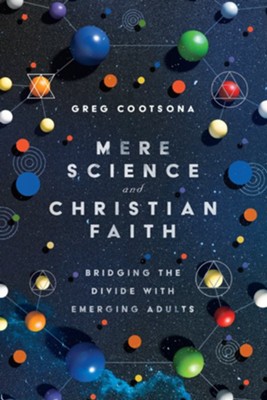
Editor’s note: This post originally appeared on Think Apologetics. Tabernacle of David considers this resource trustworthy and Biblically sound.
.

Mere Science and Christian Faith: Bridging the Divide With Emerging Adults by Greg Cootsona. IVP Academic, 2018. 192pp.
As someone who works with emerging adults on two college campuses, I took great interest in reading Mere Science and Christian Faith: Bridging the Divide With Emerging Adults by Greg Cootsona. Greg Cootsona (PhD, Graduate Theological Union) is a writer, researcher, and speaker. He directs Science and Theology for Emerging Adult Ministries (or STEAM) at Fuller Theological Seminary, and teaches religious studies and humanities at California State University at Chico. Cootsona studied comparative literature at U. C. Berkeley and theology at Princeton Theological Seminary (MDiv), the Universities of Tübingen and Heidelberg, and Berkeley’s Graduate Theological Union, where he received his PhD. He recently finished eighteen years as associate pastor for adult discipleship at Bidwell Presbyterian Church in Chico and Fifth Avenue Presbyterian in New York City.
Cootsona believes the church can do a better job of integrating science with our faith and how we can present this integration to emerging adults. Cootsona has spent considerable time with working with emerging adults and has done his research into how they think. He is aware of their views of science and how Christians view science. I should note that Coostana is on the advisory council of Biologos. This may be a red flag to Young Earth Creationists and other that espouse other creation models. I say this to not sound a major alarm. I only say this because I know how many view Biologos. Some are favorable towards it while others are not on board with them. Anyways, I am in agreement with a fair amount of what Coostsona says in this book. Having said this, I did find the chapter on Intelligent Design to be weak (granted, many in that community have responded to what he mentions about them). And while I did appreciate his chapter on the different views of The Historical Adam ( I am familiar with them), his comments that genetic studies about various populations don’t support humans coming from a pair has not gone unchallenged.
Coostana follows Ian Barbour’s approach to the relationship between science and religion. Barbour said there are four models: (conflict), (independence), (dialogue), and (integration). One thing Coostana has discovered is that many emerging adults are quite tolerant (that is part of their culture). Thus, many of them are open to the dialogue and integration view of science and religion vs the conflict/warfare view that has been repeated by Richard Dawkins, Jerry Coyne, and other popular atheistic scientists.
Coostana’s approach to the relationship between science and faith is the two books model which says we can appeal to the special revelation ( Sacred Scripture) and the Book of Nature (including the natural, physical world and the laws that govern it). When we utilize this model, science and religion can really completely divorced from one another, but rather serve complementary roles. But having said this, Coostana doesn’t see that it is necessary to provide a scientific proof for God’s existence. After all, science is the study of the natural world and science can’t possibly do such a thing. It is this reason, when it comes to Big Bang Cosmology and the Fine Tuning argument (see Ch 4), Coostana wants Christians to hold to these arguments with humility and perhaps some tentativeness. We should realize if we take science seriously, the science can change on both of these areas. He thinks we should give science five to ten years before running off and coming to a theological conclusion or making an apologetic argument.
I did enjoy the chapters on the pros and cons of technology. After all, emerging adults were raised with an over abundance of technology. It can be a good thing in that they want to use it to help humanity. There are certainly many of them that want to do this. But it can be bad in that it can enslave us and it hinders us in forming meaningful relationships. I love this quote:
“The miniature shot of dopamine (a reward hormone) as we flip from screen to screen has addictive qualities. Our phones are like slot machines, pumping us full of rewards whenever we check them. And so we continue.”- pg 121.
Overall, I found one of the most important points of the book to be that congregations have to find ways to integrate theology and science. They need to provide opportunities for learning and they need to have leaders that take the initiative to foster communication and open dialogue about the relationship between science and religion. To be fearful of science and to assume that Christians can’t engage these topics will only make the situation worse and it will continue to promote the warfare view that permeates the internet. We can do better. Thus, we need to work harder at fixing this issue. There are plenty of resources out there to help with this. So, as I finished this book, while I had a few minor quibbles, I did find the book quite helpful.

